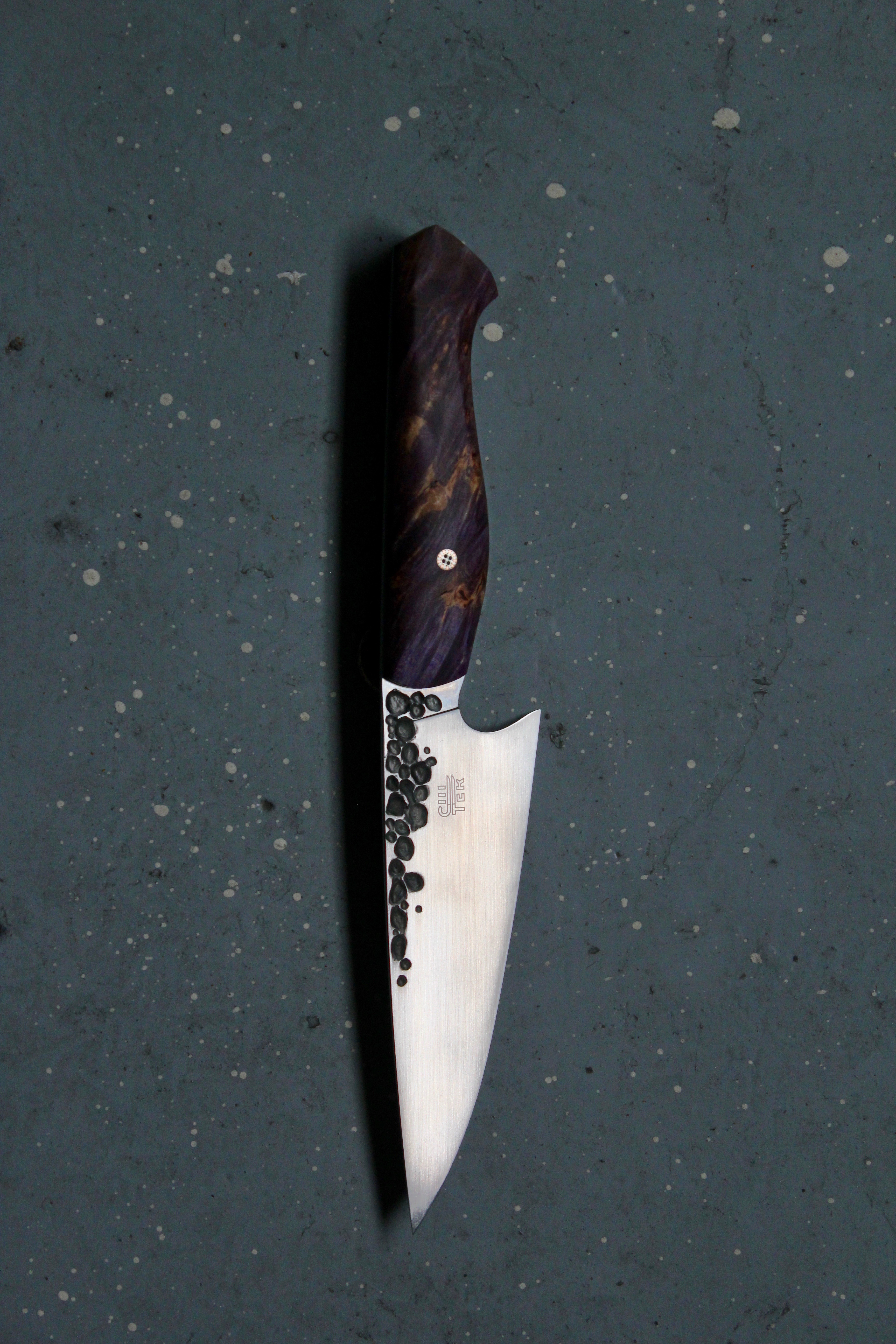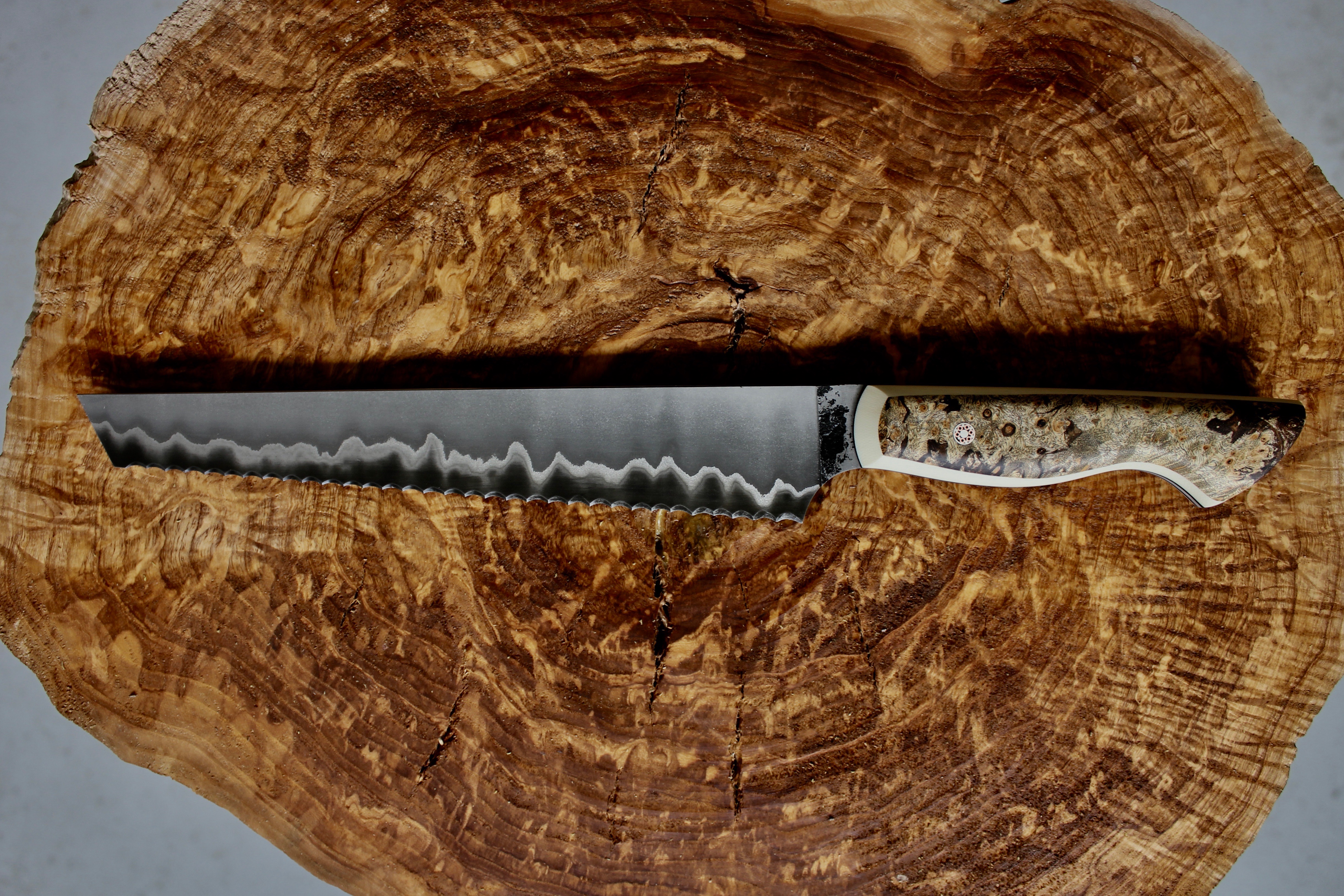
The knife is arguably the most used kitchen tool around the world, and for a serious cook, a quality, durable and functional knife is an essential gadget to have in their culinary kit.
Michael Radojkovich is the owner of Culter, a local Toronto brand that specializes in handmade custom culinary knives. The knives are beautifully constructed by Radojkovich, who learned the craft of making knives by watching YouTube videos and while working with a friend who made camp knives. When the two wanted to go in different directions with their craft, Radojkovich branched off to focus on creating high-quality culinary knives and eventually launched Culter in 2018.
The process of crafting one of Culter’s premium knives is a lengthy and detailed journey. Each one is handcrafted by Radojkovich and involves a number of steps dependent on the design and build.
Radojkovich uses a process called stock removal––a knife-making method that involves stripping off material until a knife shape is formed. The method counters the more commonly recognized and traditional way of forging, which involves heating the material up to a very high temperature and shaping it into a general knife form.
The process of stock removal is a modern method that saves time while still executing on quality. Once the knife is cut out from a bar of steel, Radojkovich then begins to further refine the knife, shaping it microscopically, finely sharpening the blade and adding a custom wood or plastic handle. The knife is also tempered and heat-treated, which will harden the knife to provide optimal performance. The entire process can take anywhere between 15 to 25 hours for each knife.
The materials are a vital part of crafting a quality knife, according to Radojkovich, and is what sets his handmade pieces apart from the typical kitchen knife. The type of material that is used can vary between different builds and will subsequently shift the overall cost of the knife.
Radojkovich typically uses a type of steel called A2; it is a relatively common metal to work with in knife-making, known for its adequate toughness and ease of sharpening from a production level all the way down to a consumer level.
At the higher-end, Radojkovich also mentions a material known as San Mai, which couples a high-carbon steel core laminated between two stainless steel layers. He says that using this type of material will result in a very fine, high-carbon cutting edge that provides an incredibly sharp quality while having the corrosion-resistant properties from the outer stainless steel sides. While this produces an extremely quality knife, the material is usually difficult to get a hold of.
This particular material needs to be forged to produce––a manufacturing concept that Radojkovich cannot do in his current facility. The only way that he can get his hands on San Mai is by purchasing it from other makers who handcraft it in the USA, which can become costly.
“It goes from twenty dollars for a piece of steel that I use to two to three hundred dollars for a piece of steel,” he says.

A comfortable and ergonomic handle is an essential component to a good knife as well. At Culter, handles are carefully crafted with either wood or a material known as G10––a fibreglass substance that has been laminated with epoxy. Radojkovich says that G10 is a “military-grade plastic” that is likely to “outlast the steel itself.”
G10 is a great handle option known for its anti-moisture properties, but Radojkovich says that people still prefer the feel and aesthetics of wood, which naturally does not handle moisture as effectively.
“What I do is stabilize my own wood which is very important, especially with kitchen knives, because they’re going to get wet,” he says.
The process of stabilizing the wood involves using a vacuum to extract all the air in the wood and filling the empty air pockets with resin. The product is then baked to harden and finished, creating a moisture barrier that looks and feels like natural wood without the worry of rotting or deteriorating over time.
“It’s still wood, but it’s almost become half wood and half plastic.”
Radojkovich has crafted custom knives for some of Toronto’s most notable chefs, including Mike Hunter of Antler and Rob Gentile of King Street Food Company.
Culter offers custom knives that are designed in accordance to what clients want, but also features a series of flagship products that are produced in abundance. These flagship knives are always in stock and ones that Radojkovich has designed himself.

Custom knives are a luxury to many casual cooks, but to a seasoned chef or an expert home cook, they are an essential tool to produce amazing food. Radojkovich says that a majority of his clients are executive chefs from across the province, but are also purchased as a gift for loved ones who are prideful of their cooking.
A good knife can certainly impact the way you cook––Radojkovich also says that once you’re at the higher-end of knives, what you pay for is the “attention to detail” and the true craftsmanship that won’t be anywhere close to what can be purchased at a big-box store. At Culter, there’s nearly no limit to what knives can be made.
“I’ve made quite a few already,” Radojkovich says. “As long as it’s in the culinary world, I’m open to making it.”
The pandemic has caused people to stay home, and in turn, has caused a sort of spark in home-cooking. Radojkovich thinks that especially in these times, a custom knife is a great option to enhance your cooking experience.
“It’s probably the tool most people use in their life because of how often you have to cook for yourself, especially now,” he says.
Those looking to upgrade their cooking experience can inquire about a custom knife through the Culter website. Radojkovich currently has his own small manufacturing space in Etobicoke, Ontario and his gorgeous craftsmanship can be admired on Culter’s Instagram page.










